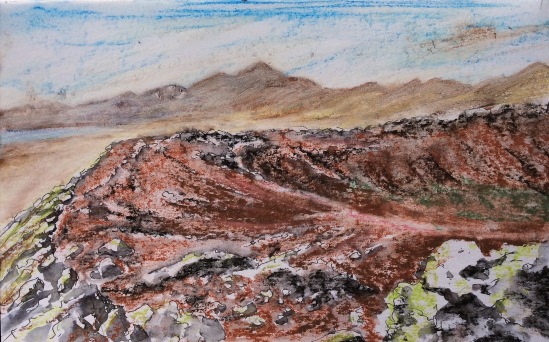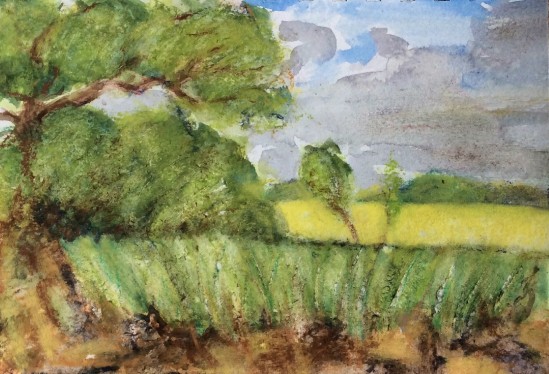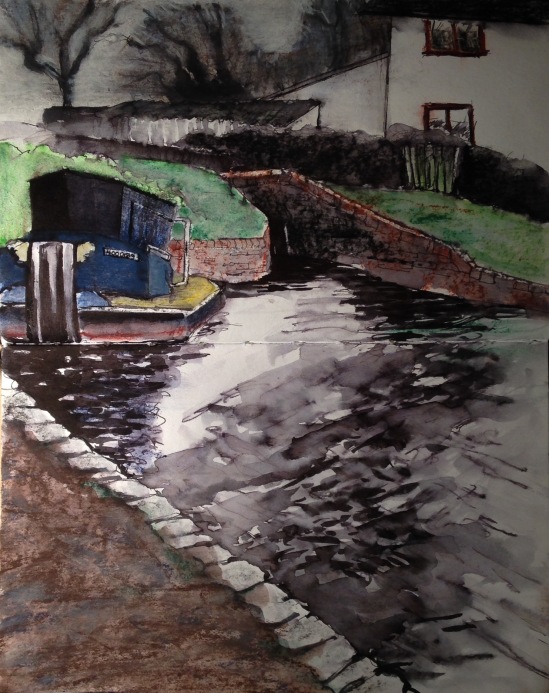A few weeks before the General Election, parties that expect to form governments stand on a platform of “financial rectitude”.
This is strange because it does not seem that peoples’ livelihoods have been threatened by lack of financial rectitude so much as by a cult-like adherence to an economic orthodoxy that sanctifies national debts to financiers over what is owed to the populace. Financial institutions created debts from nothing and sold them as assets. In this cult, money debts carry a moral imperative: sooner that someone is impoverished than the bank is not paid.

Rock shelter, built to capture moisture and encourage vegetation on the arid slope of dead volcano. Pen and ink, watercolour, conte crayon.
I have found illuminating David Graeber’s broadcast series Promises Promises: a History of Debt, available on BBC IPlayer and based on his book, Debt: the first 5000 years. Part of his thesis is that debt and credit are ancient concepts, reflecting the webs of reciprocity throughout society. Credit and debt are an essential lubricant in human relationships and enterprise, but are inherently unstable: debt tends to accumulate causing poverty and societal unrest. Periodically, ancient monarchs felt obliged to declare jubilees in which debts were annulled. What we call the economy is a much narrower concept, typically focusing on money which for us is the sharing out of national debt as currency that can be taxed.

Seaward rim of dead volcano – compressed volcanic ash eroded by the winds. Watercolour sticks, wash, pen and ink.
My other source of economic wisdom is the late Sir Terry Pratchett’s first book The Colour of Magic. The world is flat, carried on the shoulders of four elephants riding on the cratered carapace of the gigantic space-faring turtle A’Tuin. On this disc is the Wyrmburg, a massive mountain balanced upside down on its pinnacle by magic, on which beautiful near-naked warriors do ariel battle on the backs of imaginary dragons. Whatever you do, don’t stop believing: it’s a long way down to crash.

Looking across the caldera. Love tokens writ large in stones in the crater. Conte crayon
I belong to a political party which states the following on my membership card.
The Labour Party is a democratic socialist party. It believes that by the strength of our common endeavour we achieve more than we achieve alone, so as to create for each of us the means to realise our true potential and for all of us a community in which power, wealth and opportunity are in the hands of the many, not the few, where the rights we enjoy reflect the duties we owe, and where we live together, freely, in a spirit of solidarity, tolerance and respect.

Lichens colonise the seaward slopes of the volcano and vegetation concentrated where the scant waters collect in the crater. Pen and ink, conte crayon, clean water.
In this election, the Labour Party is standing on a platform of financial rectitude. Despite this, I choose to believe that, if Labour forms a government, its leader, Ed Miliband, has the toughness, intelligence and decency to respond flexibly and humanely to the challenges of the next five years.
Why is Labour’s manifesto so conservative? I guess that the leadership does see through the global economy as an illusory belief system which, while powerfully mobilising human resource, is also inherently unstable as well as being unfair, cruel and discriminatory. But I can see that it is frightening to challenge the faith. Even when escaping from the mountain balanced on its tip, one rides an imaginary dragon. Don’t stop believing: it’s a long way down to crash.





























